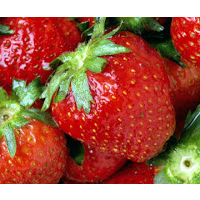Strawberry Fields—and Pesticides—Forever

Californians and strawberries have a lot in common. They both thrive in the near perfect weather of the California coast, and both have been regularly dosed with an array of dangerous pesticides for lack of a better way to grow a phenomenally lucrative crop.
The Center for Investigative Reporting (CIR) traced the sad history of the fumigants—and their champions in government and the chemical industry—that transformed the succulent fruit into a $2.6-billion-a-year business in just a few years and put more than 100 California communities at risk.
Strawberries account for at least 8% of pesticides used in the state, despite occupying less than 1% of its farmland. The threat from fumigants isn’t directly to consumers; it’s to the environment and people who live and work close to the escaping gases.
It all started, and may end, with the discovery after World War I that leftover stocks of the chemical weapon chloropicrin could be repurposed as a fumigant for agricultural products. It apparently killed troublesome worms, fungi and other parasites as effectively as it sickened soldiers.
The first success was with pineapples in Hawaii, but by the 1950s it was being injected into strawberry fields everywhere along with another chemical, methyl bromide. Other technology for growing and transporting strawberries added to the fruit boom and today Americans eat four times as many strawberries as they did in the 1970s, according to CIR.
But a funny thing happened along the way. The ozone layer around the Earth started to disappear and methyl bromide was blamed for 5-10% of the loss. In 1992, methyl bromide was banned internationally by the Montreal Protocol and just about everyone stopped using it by 2005 except strawberry farmers, who have fought hard to retain what was meant to be a temporary reprieve while they searched for an alternative.
To take up the slack, DowAgroSciences proposed around 2000 that the DPR let some growers ignore a 1990 ban on the once widely-used pesticide 1,3-Dichloropropene, a suspected carcinogen. Director Paul Helliker said OK and two years later opened the door to its widespread use. The plastic byproduct is now the third most prevalent pesticide in California and heavily used by strawberry farmers.
In 2010, it looked like methyl bromide would be replaced by methyl iodide. The chemical is an effective pesticide and easy on the ozone, but is a known mutagen and may cause cancer, nerve damage or fetal development problems for those in close proximity to fumigated fields.
The California Department of Pesticide Regulation (DPR) said it was safe if used properly. Scientists advising the state complained that their warnings were being suppressed, and internal memos uncovered in a lawsuit (pdf) included allegations that DPR management “mixed and matched” data that were “not interchangeable” to get the risk-assessment they wanted.
DPR Director Mary-Ann Warmerdam quit and went to work for Clorox about the time the documents were released. Methyl iodide is now listed under California Proposition 65 as a chemical known by the state to cause cancer or reproductive toxicity.
More than 1 million people live near areas where gases exceeding original health limits from the fumigant 1,3-D waft over the community, according to CIR.
So what’s a farmer―or a pesticide regulatory body, for that matter―to do in the face of growing resistance to the present crop of suspect pesticides? In California’s case, it has apparently turned back to an old favorite, chloropicrin.
The state officially says it is “equivocal at this time” about whether the chemical causes cancer and CIR says, “There is deep scientific disagreement on the issue.” Nonetheless, DPR is drawing up new rules for its use on the basis that it is not a carcinogen.
–Ken Broder
To Learn More:
California’s Strawberry Industry Is Hooked on Dangerous Pesticides (by Bernice Yeung, Kendall Taggart and Andrew Donohue, The Center for Investigative Reporting)
The Secret Life of California's World-Class Strawberries (by Dan Charles, NPR)
Toxic Pesticides Banned in Other Countries Continue to be Used in U.S. (by Noel Brinkerhoff, AllGov)
The Pesticide that Won’t Go Away…Watch Your Strawberries (by Noel Brinkerhoff, AllGov)
Is the State Going to Replace One Awful Pesticide with an Even Worse One? (by Ken Broder, AllGov California)
- Top Stories
- Controversies
- Where is the Money Going?
- California and the Nation
- Appointments and Resignations
- Unusual News
- Latest News
- California Forbids U.S. Immigration Agents from Pretending to be Police
- California Lawmakers Urged to Strip “Self-Dealing” Tax Board of Its Duties
- Big Oil’s Grip on California
- Santa Cruz Police See Homeland Security Betrayal in Use of Gang Roundup as Cover for Immigration Raid
- Oil Companies Face Deadline to Stop Polluting California Groundwater





